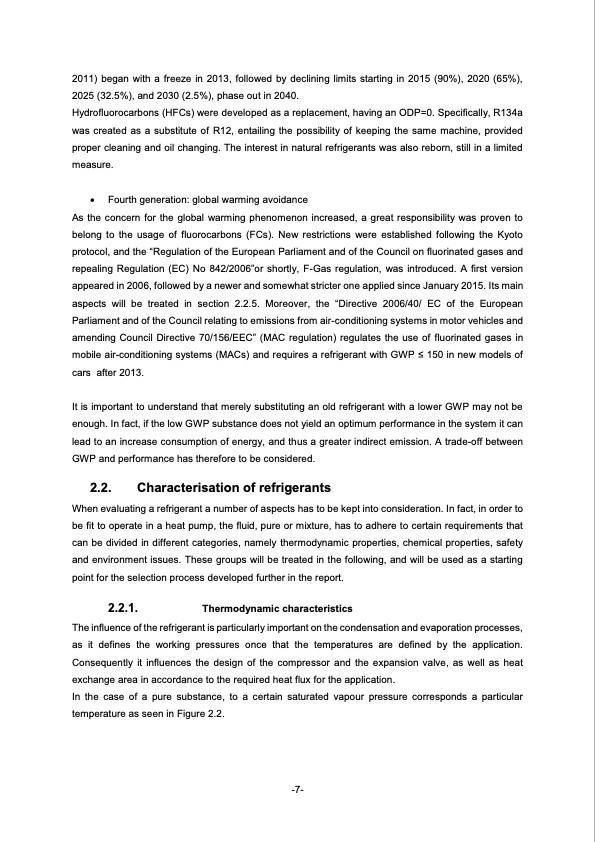
PDF Publication Title:
Text from PDF Page: 016
2011) began with a freeze in 2013, followed by declining limits starting in 2015 (90%), 2020 (65%), 2025 (32.5%), and 2030 (2.5%), phase out in 2040. Hydrofluorocarbons (HFCs) were developed as a replacement, having an ODP=0. Specifically, R134a was created as a substitute of R12, entailing the possibility of keeping the same machine, provided proper cleaning and oil changing. The interest in natural refrigerants was also reborn, still in a limited measure. Fourth generation: global warming avoidance As the concern for the global warming phenomenon increased, a great responsibility was proven to belong to the usage of fluorocarbons (FCs). New restrictions were established following the Kyoto protocol, and the “Regulation of the European Parliament and of the Council on fluorinated gases and repealing Regulation (EC) No 842/2006”or shortly, F-Gas regulation, was introduced. A first version appeared in 2006, followed by a newer and somewhat stricter one applied since January 2015. Its main aspects will be treated in section 2.2.5. Moreover, the “Directive 2006/40/ EC of the European Parliament and of the Council relating to emissions from air-conditioning systems in motor vehicles and amending Council Directive 70/156/EEC” (MAC regulation) regulates the use of fluorinated gases in mobile air-conditioning systems (MACs) and requires a refrigerant with GWP ≤ 150 in new models of cars after 2013. It is important to understand that merely substituting an old refrigerant with a lower GWP may not be enough. In fact, if the low GWP substance does not yield an optimum performance in the system it can lead to an increase consumption of energy, and thus a greater indirect emission. A trade-off between GWP and performance has therefore to be considered. 2.2. Characterisation of refrigerants When evaluating a refrigerant a number of aspects has to be kept into consideration. In fact, in order to be fit to operate in a heat pump, the fluid, pure or mixture, has to adhere to certain requirements that can be divided in different categories, namely thermodynamic properties, chemical properties, safety and environment issues. These groups will be treated in the following, and will be used as a starting point for the selection process developed further in the report. 2.2.1. Thermodynamic characteristics The influence of the refrigerant is particularly important on the condensation and evaporation processes, as it defines the working pressures once that the temperatures are defined by the application. Consequently it influences the design of the compressor and the expansion valve, as well as heat exchange area in accordance to the required heat flux for the application. In the case of a pure substance, to a certain saturated vapour pressure corresponds a particular temperature as seen in Figure 2.2. -7-PDF Image | Next generation of refrigerants for residential heat pump systems

PDF Search Title:
Next generation of refrigerants for residential heat pump systemsOriginal File Name Searched:
MartinaLonghini_ThesisReport.pdfDIY PDF Search: Google It | Yahoo | Bing
CO2 Organic Rankine Cycle Experimenter Platform The supercritical CO2 phase change system is both a heat pump and organic rankine cycle which can be used for those purposes and as a supercritical extractor for advanced subcritical and supercritical extraction technology. Uses include producing nanoparticles, precious metal CO2 extraction, lithium battery recycling, and other applications... More Info
Heat Pumps CO2 ORC Heat Pump System Platform More Info
| CONTACT TEL: 608-238-6001 Email: greg@infinityturbine.com | RSS | AMP |